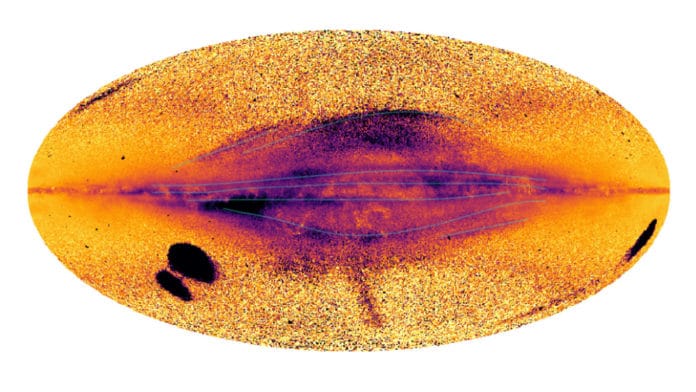While creating a map of the Milky Way’s outer disc, an international team of astronomers found structures that include evidence for fossil spiral arms. They gathered and analyzed the Gaia motion data for this work, available from December 2020.
The resulting map uncovered the presence of numerous previously obscure spinning filamentary structures at the edge of the disc. It also offers a sharper window to previously known structures.
What could these structures possibly be?
One possibility, according to scientists, might be the remains of tidal arms from the Milky Way disc, which were excited at different times by various satellite galaxies.
The Milky Way has several smaller galaxies gravitationally bound to it. Milky Way is currently known to host 59 satellite galaxies.
Past study has shown one of the filamentary structures in the outer disc, the Anticenter Stream. The structure had stars more than 8 billion years old.
Another possibility is that these structures are not real fossil spiral arms but rather form the crests of large-scale vertical distortions in the Milky Way disc.
Laporte said, “We believe that discs respond to satellite impacts which set up vertical waves that propagate like ripples on a pond.”
To distinguish between the two explanations, the team has now secured a dedicated follow-up program with the William Herschel Telescope to study the properties of the stellar populations in each substructure. Future surveys are expected to offer detailed insights into the nature and origin of these heavenly wispy structures.
Laporte comments on their findings: “Typically, this region of the Milky Way has remained poorly explored due to the intervening dust which severely obscures most of the Galactic midplane.”
“While dust affects the luminosity of a star, its motion remains unaffected. We were certainly very excited to see that the Gaia motions data helped uncover these filamentary structures! Now the challenge remains to figure what these things exactly are, how they came to be, why in such large numbers, and what they can tell us about the Milky Way, its formation and evolution.”
Journal Reference:
- Chervin F P Laporte, Sergey E Koposov, Vasily Belokurov et al. Kinematics beats dust: unveiling nested substructure in the perturbed outer disc of the Milky Way. DOI: 10.1093/mnrasl/slab109
